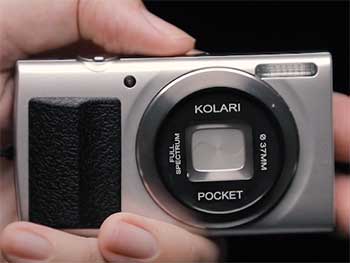In the world of infrared photography, two companies have been making waves in the market – Kolari Vision and LifePixel. Both offer specialized infrared camera conversions, giving photographers a unique experience when it comes to capturing images.
In this article, we’ll be diving into an in-depth comparison of Kolari Vision and LifePixel infrared cameras, discussing their differences and helping you decide which one is right for your needs.
So let’s get started!
A Brief Comparison Table
| Feature | Kolari Vision | LifePixel |
| Conversion Options | Full-spectrum, two-spectrum, and single-spectrum conversions | Standard infrared, enhanced color infrared, deep black and white infrared, and full-spectrum conversions |
| Customization | Higher level of customization | Good customization options |
| Conversion Quality | High-quality conversions | High-quality conversions |
| Camera Compatibility | More extensive range of camera brands and models | Limited range of camera brands and models |
| Customer Support | Responsive and helpful | Responsive and helpful |
| Educational Resources | Limited resources | Extensive tutorials and guides |
| Price | Generally higher prices | More competitive pricing |
| Warranty | Not specified | One-year warranty on conversions |
Comparing Kolari Vision And LifePixel Infrared Cameras
Now that we’ve looked at the pros and cons of both Kolari Vision and LifePixel infrared cameras let’s dive into a head-to-head comparison of their offerings.

- Customization and Options
Both Kolari Vision and LifePixel provide a variety of conversion options to suit different needs.
However, Kolari Vision has a slight edge in this area due to its broader range of customization options, including two-spectrum conversions, which LifePixel does not offer.
- Conversion Quality
When it comes to the quality of infrared conversions, both companies deliver outstanding results. The craftsmanship, attention to detail, and use of high-quality filters ensure that photographers receive top-notch converted cameras from both Kolari Vision and LifePixel.
It’s tough to declare a clear winner in this category, as both companies have earned a reputation for providing high-quality conversions.
- Camera Compatibility
In terms of camera compatibility, Kolari Vision has the upper hand. They offer conversions for a more extensive range of camera brands and models compared to LifePixel.
This means that photographers have more freedom to choose their preferred camera body when opting for a Kolari Vision conversion.
- Customer Support and Resources
Both Kolari Vision and LifePixel are known for providing excellent customer support. However, LifePixel has a slight advantage in terms of educational resources. They offer a variety of tutorials and guides on their website, helping customers get the most out of their infrared cameras.
- Price and Warranty
LifePixel generally offers more competitive pricing than Kolari Vision. While the difference in price may not be substantial for some conversion options, it can be a deciding factor for photographers on a budget.
Additionally, LifePixel provides a one-year warranty on their conversions, which gives customers added peace of mind.
Kolari Vision: A Closer Look
Kolari Vision has been in the business of infrared camera conversions since 2013. They have earned a reputation for offering high-quality conversions and exceptional customer support.
It provides a wide range of infrared and ultraviolet conversion options, catering to photographers with varying needs and preferences.
Pros of Kolari Vision Infrared Cameras
- Customization: Kolari Vision offers a diverse range of conversion options, including full-spectrum, two-spectrum, and single-spectrum conversions. This allows photographers to choose the exact type of conversion that fits their needs.
- Quality: The company is known for its attention to detail and excellent craftsmanship. Kolari Vision uses top-of-the-line filters and ensures that each conversion is done with precision.
- Compatibility: Kolari Vision offers conversions for a wide variety of camera brands and models, ensuring that photographers can choose their preferred camera body and still enjoy the benefits of a Kolari Vision infrared conversion.
- Customer Support: Kolari Vision is praised for its responsive and helpful customer support. They are always ready to assist with any questions or concerns.
Watch this review video on it.
Cons of Kolari Vision Infrared Cameras
- Price: While the quality of Kolari Vision conversions is exceptional, the prices can be relatively high, especially for some of the more specialized conversions.
LifePixel: The Competitor in Focus

LifePixel is another well-known name in the world of infrared photography.
The company has been around since 2006 and has built a loyal following of photographers who appreciate the quality of their infrared camera conversions.
Like Kolari Vision, LifePixel offers a range of conversion options and caters to photographers with different needs.
Pros of LifePixel Infrared Cameras
- Experience: LifePixel has been in the infrared conversion business longer than Kolari Vision, giving them a wealth of experience and knowledge in the field.
- Options: LifePixel offers various conversion options, including standard infrared, enhanced color infrared, deep black and white infrared, and full-spectrum conversions.
- Warranty: LifePixel provides a one-year warranty on their conversions, giving customers peace of mind.
- Tutorials: LifePixel offers a range of educational resources on their website, including tutorials and guides on infrared photography, helping customers get the most out of their converted cameras.
Cons of LifePixel Infrared Cameras
- Compatibility: While LifePixel does offer conversions for many camera brands and models, their selection is not as extensive as Kolari Vision’s.
Also Read: Differences Between RAM Mount And 67 Designs.
Final Thoughts
Both Kolari Vision and LifePixel have established themselves as leaders in the infrared camera conversion market. They both offer high-quality conversions and cater to a variety of needs and preferences. However, there are some differences between the two that can influence your decision.
If customization and camera compatibility are your top priorities, Kolari Vision might be the better choice for you. Their extensive range of conversion options and broader compatibility with various camera brands and models make them an attractive choice for photographers who value flexibility.
On the other hand, if you’re looking for more competitive pricing and additional educational resources, LifePixel might be the way to go. Their slightly lower prices and wealth of tutorials and guides can make them an appealing option, especially for those new to infrared photography.
Ultimately, the decision between Kolari Vision and LifePixel infrared cameras will come down to your specific needs and priorities. Both companies offer exceptional conversions and have a proven track record in the infrared photography market.
Whichever you choose, you’re sure to experience the unique world of infrared photography with a high-quality converted camera.



